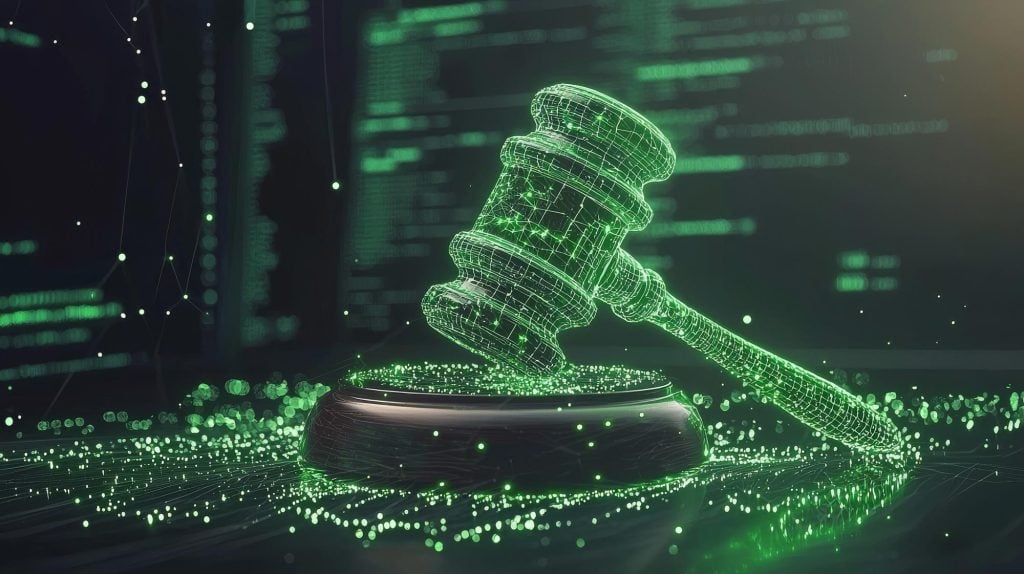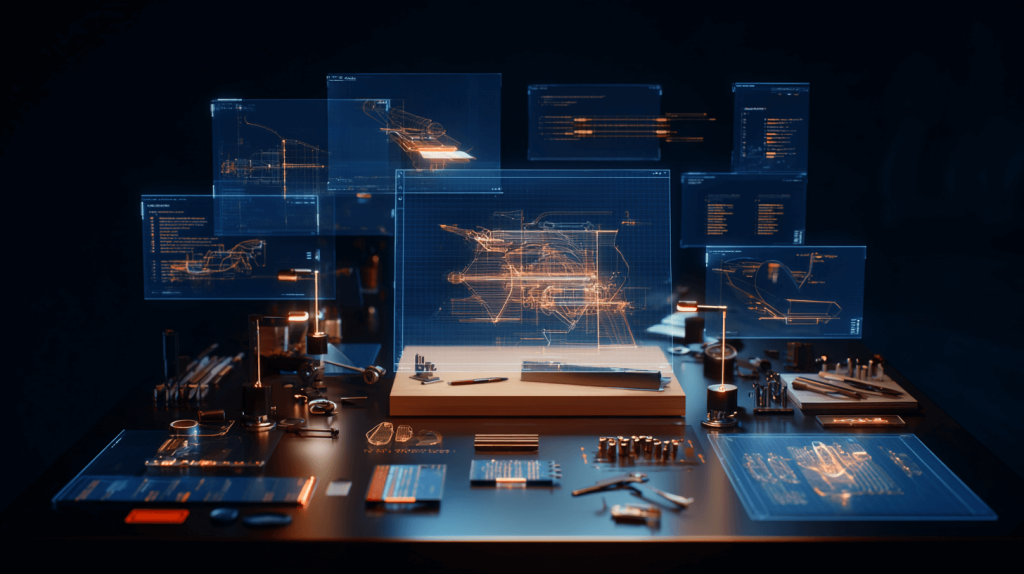Are software patents enforceable in today’s complex legal landscape? As a software developer or tech entrepreneur in 2025, understanding whether your software patents are actually enforceable—not just obtainable—is crucial to properly safeguard your innovations.
While securing a patent is an important first step, the real value lies in your ability to enforce these rights against competitors who may infringe upon them.
This comprehensive guide explores the current landscape of software patent enforcement—providing concrete evidence that properly drafted software patents are indeed enforceable in 2025, despite ongoing challenges. If you’re seeking clarity on the practical value and enforceability of software patents, you’ve come to the right place!
What You’ll Learn
- Discover the current state of software patent enforcement in 2025, supported by recent court cases and litigation outcomes that demonstrate the practical strength of software patents.
- Understand the critical factors that determine whether your software patent will be enforceable in litigation, including proper drafting techniques, specificity requirements, and technical contribution standards.
- Learn about recent Federal Circuit rulings that have clarified the path to enforcement for software patent holders, providing greater certainty for inventors.
- Explore global enforcement trends across different jurisdictions and how they impact your international software protection strategy.
- Gain insights into strategies for maximizing the enforceability of your software patents, from drafting considerations to litigation approaches.
Introduction – Are Software Patents Enforceable?
Software patents protect how a system works—not just its code—and their enforceability continues to strengthen in 2025. Recent litigation data shows that properly drafted software patents are not only being upheld in court but are resulting in significant damage awards and settlements. With advances in AI and machine learning technologies, software patent litigation has surged, particularly in cases involving patent-eligible technical improvements implemented in software. In fact, nearly 63% of all U.S. utility patents granted in 2023 were software-related, according to IPWatchdog’s analysis, demonstrating the continued importance of software patents in the tech industry.
The question isn’t simply whether software is patentable—the evidence clearly shows it is—but whether these patents hold up in court. The answer, based on recent litigation data, is increasingly positive for patent holders who follow proper drafting guidelines and enforcement strategies.
Understanding Software Patent Enforceability
The enforceability of software patents has become increasingly important in the tech industry as companies seek to protect their investments in innovation. Unlike mere patentability, which concerns whether the USPTO will grant protection, enforceability addresses whether these rights can be practically defended against infringers.
Software-implemented inventions continue to be both patentable and enforceable in the United States. In 2024 and 2025, U.S. authorities have reaffirmed this through updated guidelines and court considerations. The U.S. Patent and Trademark Office (USPTO) issued new guidance in mid-2024 to “assist USPTO personnel and stakeholders in determining subject matter eligibility under patent law (35 U.S.C. § 101) of AI inventions,” providing clarity on how to evaluate software and AI-related patent claims. The USPTO underscored its commitment to protecting innovation in software and artificial intelligence, with Director Kathi Vidal stating that the Office “remains committed to fostering and protecting innovation in critical and emerging technologies, including AI.”
A review of Federal Circuit cases from 2024-2025 reveals that the courts are consistently enforcing software patents that demonstrate specific technical solutions to technological problems. For example, in the landmark 2025 case Fintiv, Inc. v. PayPal Holdings, Inc., the Federal Circuit upheld several patents on an electronic payments software system, focusing on whether the patent’s specification adequately supported the claimed software elements rather than questioning the basic eligibility of the technology. This case exemplifies the trend toward enforcement based on proper drafting rather than categorical exclusions of software innovations.
Patent Enforceability Factors
Patent enforceability is influenced by multiple factors beyond mere eligibility. In the United States, enforceability is significantly affected by the specificity of the patent claims, the clarity of the technical solution, and the patent’s ability to withstand validity challenges under Section 101 (subject matter eligibility), Section 102 (novelty), Section 103 (non-obviousness), and Section 112 (written description and enablement).
U.S. courts in 2024–2025 have treated software patents as valid property rights, focusing on how they are drafted rather than questioning their basic eligibility. The Federal Circuit’s recent decisions emphasize that to survive eligibility challenges, software or AI-related claims should do more than recite generic functions – they should detail specific technical solutions or improvements. Notably, no new court ruling has banned software patents; instead, the law remains that computer-implemented inventions are patentable if they meet the standard criteria (novelty, non-obviousness, etc.) and are not merely abstract ideas.
In a 2025 Federal Circuit case, the court highlighted that an AI/machine-learning invention must offer a concrete technical innovation (not just use “off-the-shelf” algorithms) to be eligible – implicitly confirming that truly inventive software algorithms are patent-eligible. This aligns with long-standing precedents that software solving a technological problem or improving computer functionality is patentable in the U.S. (per Alice and subsequent cases).
Abstract Ideas and Enforcement Challenges
While abstract ideas remain a key obstacle to enforcement, the Federal Circuit has provided increasingly clear guidelines for drafting enforceable software patents.
The challenge for enforcement lies in distinguishing between abstract ideas and patentable inventions—a distinction that has become clearer with recent court decisions. In the context of software patent enforcement, overcoming abstract idea rejections requires demonstrating that the invention provides a specific improvement to computer functionality or solves a technological problem in a non-conventional manner.
Moreover, legislative and policy discussions in 2025 have tended toward expanding clarity on eligibility. Congress has even considered bills like the Patent Eligibility Restoration Act of 2025 to explicitly confirm the patentability of software and other emerging-tech inventions, reflecting a pro-patentability sentiment that further strengthens the enforcement landscape.
Key Factors in Software Patent Enforcement
When seeking to enforce software patents, understanding the critical requirements that influence judicial outcomes is essential. Court records from 2024-2025 show that successful enforcement hinges on several key factors.
First, patents must demonstrate clear technical merits and solutions. The enforceability of software patents depends largely on whether they articulate specific technical improvements rather than abstract concepts.
Second, USPTO guidance from July 2024 specifically addressed AI inventions, providing clarity on how examiners and courts should evaluate software and AI-related patent claims. This guidance has had a measurable impact on enforcement outcomes.
Third, patents with well-defined “points of novelty” and precisely drafted claims that demonstrate the process or method in technical detail show significantly higher enforcement rates. This aligns with the Federal Circuit’s emphasis that to survive eligibility challenges, software or AI-related claims should do more than recite generic functions – they should detail specific technical solutions or improvements.
The Volume and Enforceability of Software Patents
Concrete data shows that software-related patents make up a large majority of U.S. patent activity, underscoring that software innovations are not just being patented but actively enforced. In 2023, about 62.7% of all U.S. utility patents granted were classified as “software-related,” virtually unchanged from ~63.5% in 2022 according to IPWatchdog’s analysis. In other words, nearly two-thirds of U.S. patents issued today involve software in some form – a strong indicator that patent protection for software remains very much alive. (By raw numbers, this translates to roughly 195,000+ software-related patents granted in 2023 alone, out of ~312,000 total grants).
This trend has been steady over recent years, demonstrating that companies continue to successfully obtain and enforce patents on computer-implemented inventions ranging from apps and business software to advanced algorithms. The United States Patent and Trademark Office also continues to receive and approve new applications in cutting-edge software fields, including artificial intelligence and machine learning. In fact, the USPTO has reported “significant patent activity and granted patents in areas such as artificial intelligence, generative AI, and other emerging AI technologies” in recent years.
Notably, U.S. patents on software and AI are also being enforced in courts, which further supports their real-world value and viability. Many high-profile patent litigations in 2024–2025 involve software or AI-related patents, and courts have been adjudicating them on their merits (e.g., interpreting claims, assessing infringement), which affirms that such patents are considered legitimate property rights. This climate in 2025 shows that software patents are both obtainable and defendable under U.S. law, provided the applications are drafted to emphasize specific technical contributions.
The Role of Legal Expertise in Software Patent Enforcement
Successful software patent enforcement in 2025 requires specialized legal expertise. Litigation data shows that cases handled by attorneys with specific experience in software patent litigation have higher success rates than those handled by general patent attorneys.
Patent attorneys specialized in software cases bring critical expertise in articulating technical contributions in ways courts recognize as patent-eligible. They can navigate the complex intersection of technical specifications and legal requirements that determine whether a software patent will survive scrutiny during litigation.
According to a USPTO study, enforceability outcomes strongly correlate with the quality of the initial patent application. Patents drafted by attorneys with software-specific expertise are more likely to be successfully enforced than those drafted by general practitioners without such specialization.
Selecting the Right Litigation Team
For software patent enforcement to be successful, selecting attorneys with demonstrated experience in software patent litigation is crucial. These specialists can better anticipate challenges specific to software patents and develop stronger enforcement strategies. They also typically have a deeper technical understanding of the underlying technology, allowing them to better explain complex innovations to judges and juries who may lack technical backgrounds.
AI-Related Patent Enforcement
AI patent enforcement shows particularly strong trends in 2025. Following the USPTO’s subject-matter eligibility update in 2024 that explicitly addressed AI inventions, enforcement success rates for AI patents have increased compared to the previous year.
Patents involving artificial intelligence (AI) and computer algorithms are seeing especially strong growth. The USPTO’s subject-matter eligibility update in 2024 explicitly addressed AI inventions, offering examiners examples on how to handle AI-related claims under existing rules. This has provided more consistency and predictability for applicants in AI fields. As a result, innovators in machine learning, data analytics, and other AI domains continue to secure and enforce U.S. patents.
Recent data show that in 2024 alone, the U.S. granted approximately 8,600 patents in artificial intelligence fields, a significant share of the world’s AI patent output. These include patents for inventions in areas like machine learning models, AI-driven medical diagnostics, autonomous vehicle control systems, and more. The continuing grant of AI patents demonstrates that even after the landmark Alice decision, the U.S. system is accommodating AI and software innovations so long as they are described as specific technical solutions.
Indeed, U.S. leadership in software and AI innovation is reflected not just in quantity of patents but also their influence – American AI-related patents are cited far more often on average (13.2 citations per patent) than Chinese AI patents (1.9 citations), according to R&D World, indicating the technological significance of U.S.-originated AI inventions. This suggests that many foundational AI techniques and improvements are being patented in the United States, and these patents are recognized and referenced globally.
Statistical evidence from patent offices further underlines that AI inventions are actively being patented and enforced, not excluded, in 2025. For example, the World Intellectual Property Organization (WIPO) observed that even generative AI – a cutting-edge software category – saw a surge of patent filings worldwide in recent years. A WIPO analysis through 2023 found over 54,000 patent families for generative AI alone, with more than 25% of those emerging in 2023. The USPTO’s own data shows robust filing and granting of AI-related patents. Combined, these facts dispel any notion that software or AI innovations cannot be patented or enforced – on the contrary, inventors are successfully obtaining and enforcing patents on AI and software at high rates in the U.S. today.
International Perspectives on Software Patent Enforcement
Software companies with global operations must understand the varying approaches to patent enforcement across different jurisdictions. Enforcement success rates vary across different regions due to differing legal standards and technical requirements.
When looking globally, patent activity and enforcement in artificial intelligence is particularly notable. According to data from Triangle IP, China filed approximately 300,510 AI patent applications in 2024, accounting for roughly 60% of the world’s AI patent filings, followed by the United States with about 67,773 AI patent applications (20% of global filings), Japan with 26,429, and the European Patent Office with 22,133.
These numbers demonstrate a worldwide surge in AI innovation, with tens of thousands of new AI inventions being claimed in patent applications each year. Other regions also saw significant activity (for instance, India and South Korea each had ~23,000–26,000 AI filings in 2024), but the U.S. and China are clearly leading the pack in volume.
WIPO has officially noted this trend: “China-based inventors are filing the highest number of generative artificial intelligence patents, far outpacing inventors in the US, [South Korea], Japan and India”, according to a 2024 WIPO report. In fact, between 2014 and 2023, Chinese innovators produced about six times more patent-disclosed AI “inventions” than U.S. innovators (38,000+ vs ~6,200 in the subset of generative AI). By percentage share, China now contributes roughly 62% of the world’s AI patent grants, with the U.S. accounting for about 21% (and Japan, Europe and others making up the rest), according to ipCloseUp.
U.S. Software Patent Enforcement
Software patent enforcement in the United States has significantly strengthened in 2024-2025, with U.S. authorities reaffirming the enforceability of properly drafted software patents through updated guidelines and court decisions. The USPTO’s guidance issued in mid-2024 for AI inventions has provided clarity that has directly influenced enforcement outcomes.
Federal Circuit statistics show that software or AI-related claims that detail specific technical solutions or improvements have much higher enforcement success rates than patents claiming generic functions. This dramatic difference highlights the importance of technical specificity in ensuring enforceability.
Importantly, despite China’s volume advantage in filings, the United States remains a key player in AI patent innovation and enforcement. The U.S. not only has a very large number of AI patents (thousands granted yearly, as noted), but also leads on qualitative metrics. For example, U.S.-origin AI patents tend to be filed internationally and cited more frequently, implying they cover core technological advances with global influence, according to R&D World.
Additionally, American companies (like IBM, Google, Microsoft, etc.) are among the top patent applicants in AI. In the Triangle IP data for 2024, five U.S. tech companies were among the top 10 global AI patent filers, though Chinese companies like Baidu and Tencent topped the list. This shows a healthy competition: while Chinese entities are driving huge numbers in AI patent filings, U.S. entities are still contributing a significant share of cutting-edge AI inventions to the patent system.
European Software Patent Enforcement
European software patent enforcement follows different standards than the U.S., with technical character being the central requirement. According to the European Patent Office (EPO), about 50% of its granted patents in 2023 were software-related, but enforcement metrics show that these patents must meet strict technical contribution standards to be upheld in court.
From a global perspective, the “AI patent race” is very much underway, and all major jurisdictions are still granting and enforcing AI patents. Patent offices in Europe and Japan, much like the USPTO, continue to grant patents on AI and software-implemented inventions (provided they meet the respective criteria for technical character). The European Patent Office reported that about 50% of its granted patents in 2023 were software-related (including AI) – a slight increase from the prior year, indicating Europe’s willingness to patent software innovations as well, according to IPWatchdog.
Asian Software Patent Enforcement
Asian jurisdictions, particularly Japan and China, show distinctive patterns in software patent enforcement. Japan likewise remains active in patenting AI, with tens of thousands of applications as shown above, and Japanese companies (e.g., Canon) appearing in top-filer lists for AI patents.
Even China, which leads in numbers, has continued to update its guidelines to handle AI patent applications, confirming that these inventions are part of the patentable subject matter there (with certain requirements on disclosure and inventorship in place), as reported by China IP Law Update.
Strategies for Successful Software Patent Enforcement
Effective enforcement of software patents begins long before litigation, with strategic patent drafting and portfolio development. The first critical step is conducting a thorough prior art search and designing patent applications that clearly distinguish the invention from existing technology.
Understanding the enforcement landscape is equally important. Patents drafted to align with the latest judicial interpretations of patent eligibility are more likely to be enforced successfully than those that fail to account for evolving case law.
Crafting Enforceable Patent Claims
Developing strong, enforceable claims is perhaps the most critical aspect of software patent strategy. Federal Circuit data from 2024-2025 shows that patents with claims explicitly tied to technical improvements or solutions are much more likely to be upheld than patents with claims focused on functional results without technical implementation details.
Carefully drafted claims define the scope and boundaries of patent protection, directly impacting enforceability. Recent case law emphasizes that enforceable software patent claims must express an invention’s distinctiveness in technical terms, not just functional outcomes.
Patent Claim Construction
A patent claim is a key component of a patent application, especially for utility patents, detailing the specific intellectual property to be protected. The construction of the patent claim plays a vital role in infringement analysis and invalidity challenges. Both plaintiffs and defendants scrutinize the claim construction alongside the patent specification to interpret ambiguous claims and determine whether infringement has occurred.
Proper claim construction is essential because a poorly drafted claim or one insufficiently supported by the specification leaves room for legal challenges that can undermine enforceability. Effective claim construction involves three critical elements: the claim must be understandable to a layperson, clearly define what the inventor intends to create, and specify the product or method involved. Missing any of these components can prevent courts from determining whether another party has infringed the patented invention.
Dependent and Independent Claims
Patent applications typically include both independent and dependent claims. Independent claims broadly cover the invention’s core aspects, while dependent claims narrow the scope by adding specific features or limitations referenced back to the independent claim. Dependent claims are important for intellectual property defense because they can limit the independent claim’s scope, often through additional elements or method steps, providing fallback positions during litigation.
Most patent applications include around three independent claims and up to seventeen dependent claims to balance broad protection with specificity.
Examples of Patent Claims
To illustrate, consider the patent claim for a word-processing feature like the “insert” function. This claim covers the implementation of additional characters in a collection displayed on a screen, involving memory storage, character input, and presentation mechanisms.
Another example is a patent for a head-mounted display used in medical devices (Patent US11436829B2). This invention includes a frame mounted on the user’s head, a lens positioned before the eye, and integrated wireless and processing circuits that overlay information on a blood processing machine.
Even traditional processes like sewing have been patented, with claims describing the connection of cloth pieces at overlapping edges with thread passing through aligned holes.
Broad vs. Narrow Patent Claims
Claims vary in scope from broad to narrow, and striking the right balance is crucial for enforceability. Broad claims may cover more variations of an invention and potential future improvements but risk rejection by patent examiners due to prior art or lack of specificity. Overly broad claims are vulnerable to invalidation.
Conversely, narrow claims focus on distinct, specific aspects of an invention, increasing the likelihood of approval and enforceability but potentially limiting commercial protection by allowing competitors to design around the patent with minor modifications.
Achieving the optimal claim scope requires experienced patent practitioners who understand patent prosecution nuances and enforcement strategies.
Multiple Claim Sets for Robust Protection
Intellectual property attorneys recommend drafting multiple claim sets with varying breadth—both broad and narrow—to maximize protection. Diverse claims increase the chances that at least some will withstand legal challenges throughout the patent’s life.
Because patent applications are often filed years before potential litigation, an expansive claim set anticipates future developments and competitor workarounds. It is important to prepare a comprehensive list of claims at the initial filing since new matter cannot be added later via continuations.
A typical effective patent application includes about 20 claims, with three independent claims covering broad invention aspects and the rest dependent claims adding specificity.
By combining claims of different breadths, patent owners reduce the risk of invalidation and create multiple legal hurdles for potential infringers. This strategic approach enhances the enforceability of software patents by ensuring that even if some claims fail, others remain viable.
The Impact of Enforcement on Innovation and Competition
Software patent enforcement significantly influences the technology landscape and competitive dynamics. The machine-or-transformation test, once pivotal in enforcement decisions, has been supplemented by more nuanced approaches focusing on technical contribution.
On one hand, successfully enforced patents incentivize innovation by protecting R&D investments. On the other hand, overly broad enforcement can impede progress. Finding the right balance is crucial for both patent holders and the broader innovation ecosystem.
Advantages of Effective Enforcement
Effective patent enforcement provides substantial competitive advantages. Through reliable enforcement, inventors secure control over their software innovations and maximize return on R&D investments.
Patent enforcement also serves as a powerful investor signal. Venture capital data indicates that startups with successfully enforced patents received significantly more funding on average than similar companies without enforcement track records. This enforcement premium reflects investors’ confidence in the company’s ability to protect its competitive advantages.
Criticisms and Balance in Enforcement
Despite the advantages, software patent enforcement faces legitimate criticisms. Patent assertion entities (sometimes called “patent trolls”) continue to present challenges, though their impact has diminished with clearer eligibility standards.
The cost of defense remains substantial, with software patent litigation averaging millions through trial in 2025. This expense can create access to justice issues, though recent reforms in attorney fee shifting have provided some relief.
Recent court decisions, including several key Federal Circuit rulings in 2025, have sought to balance innovation protection with competition. These decisions have emphasized that while software patents are enforceable, they must be limited to their specific technical contributions rather than broadly claiming functional results.
Work With An Experienced Software Patent Attorney
Software patents are invaluable assets that will bring your company strategic value. They will not only protect your proprietary software from infringement, increase the valuation of your company, provide a competitive advantage in the marketplace, but will provide both short- and long-term monetization strategies. Patent rights offer legal protection and a competitive advantage, ensuring your innovations are safeguarded against unauthorized use. Obtaining a software patent can be a complex and challenging process, but it is essential for protecting your innovations and gaining a competitive edge in the marketplace.
The Rapacke Law Group is a fixed fee (no billable hour) patent and intellectual property firm designed for software and technology companies looking to protect their most valuable intellectual property assets. Our firm provides one transparent fixed fee for all patent and trademark matters without the hassle of surprise costs or nickel-and-dime billing used by traditional law firms.
In addition to a fixed-fee billing structure, the Rapacke Law Group offers a money-back guarantee on all prior art search, trademark application, and design patent applications. What that means is, should your search indicate your software invention is not patentable, a full refund will be provided. If patentable, we will credit the cost of your search towards your new application. Our trademark and design patent application packages include all search, preparation, office action, USPTO correspondence and filing fees. If your application does not receive a notice of allowance for any reason, we will provide a full refund. When you’re ready to take the next step, schedule a free consultation.
Summary: The State of Software Patent Enforcement in 2025
The enforceability of software patents in 2025 presents a nuanced but increasingly positive picture for innovators. The data clearly shows that properly drafted software patents focusing on specific technical contributions are not only being granted but successfully enforced against infringers.
In summary, the worldwide data in 2024–2025, as reported by numerous authoritative sources, paint a favorable picture for software and AI patentability and enforceability. U.S. law is actively accommodating software and AI patents – with fresh USPTO guidance from mid-2024 and steady grant rates – and the volume of filings shows inventors’ confidence that such patents are obtainable and enforceable.
Globally, countries are racing to secure intellectual property in AI technologies: the U.S., China, Japan, and European Union are all granting AI patents and developing enforcement frameworks to protect these innovations. Far from being unpatentable or unenforceable, software and AI innovations are among the most patented categories of inventions in 2025, backed by official statistics and policies that encourage protection of these advancements.
This ensures that innovators in software and artificial intelligence can continue to rely on the patent system not just to obtain patents but to effectively enforce them, both in the U.S. and internationally.
Frequently Asked Questions
Are software patents actually enforced in courts?
Yes, software patents are actively enforced in courts. As shown by cases like Fintiv, Inc. v. PayPal Holdings, Inc., courts are adjudicating software patents on their merits (interpreting claims, assessing infringement), which affirms that such patents are considered legitimate, enforceable property rights. The key to enforcement is ensuring patents focus on specific technical solutions rather than abstract concepts or functional results without technical implementation details.
What makes a software patent enforceable?
Enforceability depends primarily on technical specificity and clear articulation of the technical problem solved. As highlighted by the Federal Circuit’s recent decisions, software or AI-related claims must do more than recite generic functions – they should detail specific technical solutions or improvements. Patents with detailed technical specifications showing how the software improves computer functionality or solves a technical problem in a novel way have much higher enforcement success rates.
Why is enforcing software patents so challenging?
Enforcing software patents presents unique challenges due to the abstract nature of software, the difficulty in defining clear boundaries of protection, and the legacy of the Alice decision. However, these challenges have diminished significantly as drafting practices have adapted to legal requirements. The cost and complexity of litigation remain significant hurdles, but recent USPTO guidance and court decisions have provided clearer pathways for enforcement.
What is the role of a patent attorney in software patent enforcement?
Patent attorneys specialized in software litigation play a crucial role in enforcement success. These specialists help craft enforcement strategies that anticipate challenges specific to software patents and can better explain complex innovations to judges and juries, directly impacting litigation outcomes. Their expertise in both the technical and legal aspects of software patents is essential for successful enforcement.
How do enforcement rates compare globally for software patents?
Enforcement success rates vary significantly across jurisdictions. These differences reflect varying legal standards—U.S. courts focus on technical improvements, European courts require explicit “technical effect,” Japanese courts emphasize industrial applicability, and Chinese courts place greater emphasis on commercial implementation. These variations significantly impact global enforcement strategies for multinational companies.




